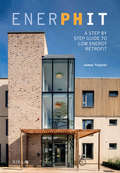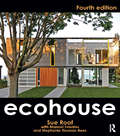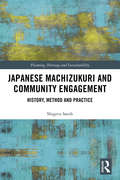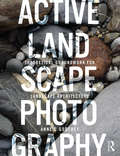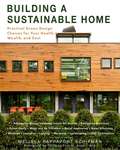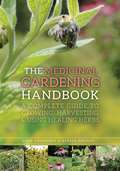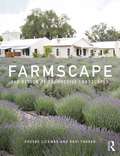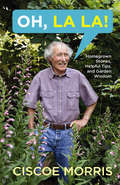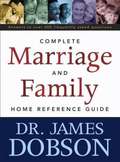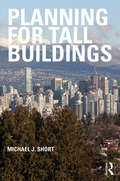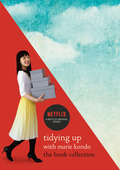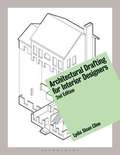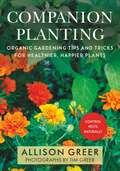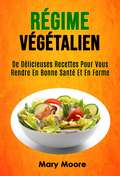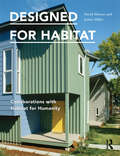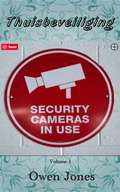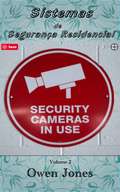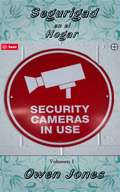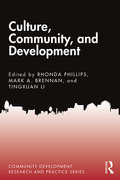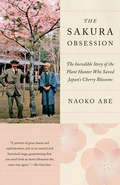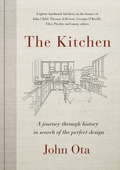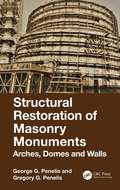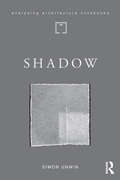- Table View
- List View
EnerPHit: A Step by Step Guide to Low Energy Retrofit
by James TraynorIn order to meet UK Carbon reduction commitments for 2020 and 2050 building owners will be required to upgrade their buildings to meet an increasingly stringent set of energy performance requirements. In the absence of any clear advice from UK Government on how this can be achieved, the EnerPHit standard offers a very clear methodology. This is a practical guide that gives architects the tools to retrofit buildings to the highest EnerPHit standard. It equips the reader with the key information on EnerPHit (as the most effective benchmark for performance), the practical know-how and tips to ensure effective retrofit throughout all Plan of Work stages of a project to the EnerPHit standard. Backed with real-life case studies, it enables you to understand how to achieve successful outcomes tailored to suit available budgets and programmes.
Ecohouse
by Sue Roaf Manuel Fuentes Stephanie Thomas-ReesSue Roaf is famed for her approach to design and her awareness of energy efficiency. Here she reveals the concepts, structures and techniques that lie behind the realization of her ideals. By using her own house as a case study, Roaf guides the reader through the ideas for energy-efficient design or 'eco-design'. Now in its fourth edition, the bestselling Ecohouse continues to be both a technical guide and an inspiration for thousands of architects, designers and eco-builders all over the world. Ecohouse provides design information about the latest low-impact materials and technologies, showcasing the newest and best ‘green’ solutions. Revised and updated, this edition also includes new case studies inspiring readers with more real-life examples of how to make an ecohouse work.
Japanese Machizukuri and Community Engagement: History, Method and Practice (Planning, Heritage and Sustainability)
by Shigeru SatohOver the past few decades, Japan has faced severe earthquake disasters, an increasing aging population, declining birth rates, and widening social disparities. These issues have served to highlight gaps left by top-down governance approaches and the urgent need to create resilient societies using more traditional models. Japanese “machizukuri” has developed to become an exceptional example of bottom-up creative approaches based on collective action and use of local resources. Since its evolution in the 1960s, machizukuri has come to define diverse and creative community-driven management models, by which local communities are enabled to actively tackle problem-solving. Including contributions from experts directly engaged in the process, this book explores the original development of machizukuri in Japan, its diffusion through East Asia and the positive outcomes of this transfer. Combining theoretical explanations with practical case studies, from pre-disaster planning in Tokyo, to the revitalization of historic towns and rural areas around Japan, the book looks at specific solutions, tools, and links between academics, communities, organizations, governmental bodies, and the private sector. It will appeal to researchers in planning, community engagement, architecture, urban design, and sustainable development.
Active Landscape Photography: Theoretical Groundwork for Landscape Architecture
by Anne C GodfreyPhotographs play a hugely influential but largely unexamined role in the practice of landscape architecture and design. Through a diverse set of essays and case studies, this seminal text unpacks the complex relationship between landscape architecture and photography. It explores the influence of photographic seeing on the design process by presenting theoretical concepts from photography and cultural theory through the lens of landscape architecture practice to create a rigorous, open discussion. Beautifully illustrated in full color throughout, with over 200 images, subjects covered include the diversity of everyday photographic practices for design decision making, the perception of landscape architecture through photography, transcending the objective and subjective with photography, and deploying multiplicity in photographic representation as a means to better represent the complexity of the discipline. Rather than solving problems and providing tidy solutions to the ubiquitous relationship between photography and landscape architecture, this book aims to invigorate a wider dialogue about photography's influence on how landscapes are understood, valued and designed. Active photographic practices are presented throughout for professionals, academics, students and researchers.
Building a Sustainable Home: Practical Green Design Choices for Your Health, Wealth, and Soul
by Schifman MelissaThe green building movement has produced hundreds of “how-to” books and websites that are filled with tips about green building and what homeowners should do to go green. While helpful and informative, when it comes to making actual purchasing and installation decisions, these books do not make it any easier for a homeowner to prioritize against a budget. The Sustainable Home serves this need, as it is written by a sustainability advisor and financial advisor who has personally directed the building and LEED certification of her own home. Here, she shares her knowledge and experience for others to use in their journey toward a greener way of living. Whether the reader is building a new home or doing a minor remodel, a homeowner needs a framework by which to guide their decisions. These decisions are based on values, and the author posits that there are really only three reasons to go green: For Our Health: By building more sustainably, we reduce our exposure to harmful chemicals and toxins. For Our Wealth: By building a more durable home and being more efficient with resources like water and electricity, we reduce our monthly utility bills and ongoing maintenance expenses. For Our Soul: Collectively doing the right thing for our planet does make a difference—and that is soul-nourishing. Learn the logistics of choosing windows, insulation, appliances, and lighting. Find out about FSC certified wood and about using reclaimed materials. Here is everything you need to make your home sustainable.
The Medicinal Gardening Handbook: A Complete Guide to Growing, Harvesting, and Using Healing Herbs
by Dede Cummings Barbara Fahs Alyssa HolmesDig into the world of herbal medicine with this complete guide to cultivating and harvesting plants with healing properties. For thousands of years people have been utilizing herbs and cultivating weeds found to speed the healing of wounds, soothe skin irritations, calm uneasy stomachs, and ward off illnesses. Now you can plan and grow your own garden first aid kit.In these pages, you'll learn the basics of gardening in your backyard-or on your windowsill or porch-including instructions for preparing soil, composting, and weeding. You'll then find detailed descriptions of the twelve most common, easy-to-grow, most useful healing herbs, with instructions for growing, harvesting, and utilizing them. These powerful plants include: Garlic, which boosts immunity, reduces blood pressure, and combats cancer Echinacea, which reduces inflammation, boosts immunity, and has antiviral properties Yarrow, which accelerates the healing of wounds, is an anti-inflammatory, and can relieve PMS symptoms Elderflower, which is an astringent and can relieve arthritis and soothe sore throats Mint, which soothes digestive problems, sweetens breath, and can reduce fevers Elecampane, a respiratory tonic with antibacterial and antifungal properties And more!
Farmscape: The Design of Productive Landscapes
by Phoebe Lickwar Roxi ThorenFarmscape: The Design of Productive Landscapes situates agriculture as a design practice, using a wide range of international case studies and analytical essays to propose lessons for contemporary landscape architects who are interested in integrating agriculture into their designs. Agricultural processes, technologies, and cycles have long shaped landscape architectural projects, from the ornamented farm of the eighteenth century, to contemporary projects that integrate agriculture and ecological restoration. The book describes the history of agriculture within landscape architecture and reveals the diversity of current design practices that use the rhythms and forms of agriculture to create productive farms that are also sites of beauty, community, ecological conservation, remediation, and pleasure. Highly illustrated in full colour, this book provides essential context, resources, and best practice examples of rural and periurban designed sites for professionals and students alike.
Oh, La La!: Homegrown Stories, Helpful Tips, and Garden Wisdom
by Ciscoe MorrisThe most beloved and respected gardening expert of the Pacific Northwest, Ciscoe Morris, entertains us with gardening stories and shares advice, information, and wisdom from a career that has spanned 45 years and is still going strong.With heart and humor, Ciscoe Morris regales us with stories from the gardens he has tended, the wildlife he has encountered--deer, moles, rats, birds, and more--the dogs who have joined him on his travels, the secret lives of insects, and his endeavors as head gardener at Seattle University. Each story will make you smile but will also contain a nugget of gardening wisdom or a practical, helpful tip that home gardeners will be able to put to use in their own gardens.
Complete Marriage and Family Homes Reference Guide
by Dr James DobsonThe Complete Marriage and Family Home Reference Guide by Dr. James Dobson, America's most respected expert on marriage, parenting, and the family. This comprehensive, easy-to-access resource offers time-tested, biblical based information to help build healthy, God-honoring families.
Planning for Tall Buildings
by Michael J. ShortIn a time of recession, the challenge of building and planning for tall buildings has become even more complex; the economics of development, legislative and planning frameworks, and the local politics of development must be navigated by those wishing to design and construct new tall buildings which fit within the fabric of their host cities. This book is a timely contribution to the debate about new tall buildings and their role and effect on our cities. It is divided into two main parts. In part one, the relationship between tall buildings and planning is outlined, followed by an exploration of the impacts that construction of tall buildings can have. It focuses, in particular, on the conservation debates that proposals for new tall buildings raise. The first part ends with an analysis of the way in which planning strategies have evolved to deal with the unique consequences of tall buildings on their urban locations. The second part of the book focuses on seven examples of medium-sized cities dealing with planning and conservation issues, and implications that arise from tall buildings. These have been chosen to reflect a wide range of methods to either encourage or to control tall buildings that cities are deploying. The case studies come from across the western world, covering England (Manchester, Liverpool, Newcastle and Birmingham), Norway (Oslo), Ireland (Dublin) and Canada (Vancouver) and represent a broad spectrum of approaches to dealing with this issue.In drawing together the experiences of these varied cities, the book contributes to the ongoing debate about the role of the tall building in our cities, their potential impacts, and experiences of those who use and inhabit them. The conclusions outline how cities should approach the strategic planning of tall buildings, as well as how they should deal with the consequences of individual buildings, particularly on the built heritage.
Tidying Up with Marie Kondo: The Life-Changing Magic of Tidying Up and Spark Joy
by Marie KondoDiscover the books that inspired the Netflix phenomenon Tidying Up with Marie Kondo, now together in a convenient ebook bundle: The Life-Changing Magic of Tidying Up and Spark Joy.Japanese decluttering expert Marie Kondo has taken the world by storm with her Netflix show, Tidying Up with Marie Kondo. Now fans can get the two books that started the movement, The Life-Changing Magic of Tidying Up and Spark Joy, in one ebook bundle that combines this philosophical wisdom, practical advice, and charming prescriptive illustrations into one master class. The Life-Changing Magic of Tidying Up is Kondo&’s guide to decluttering your home using her famed KonMari Method, and Spark Joy is an illustrated manual with step-by-step instructions for folding clothes and tackling messy areas of the home. With these two books, you can capture the joy of Marie Kondo&’s tidy lifestyle for yourself.
Architectural Drafting For Interior Designers
by Lydia ClineBeginning interior designers can learn how to graphically communicate their ideas with a resource that is designed specifically for them. While traditional drafting books focus on architectural and engineering readers, Architectural Drafting for Interior Designers, Second Edition, eliminates irrelevant coverage and incorporates material and examples that are meaningful to today's interior designers. This book also addresses the specific needs of beginning interior designers by focusing on topics needed before AutoCAD is even introduced, such as how to draw a floor plan, how to use it to create an interior elevation, and how to understand the relationship between 2D and 3D drawings. Updated to include a new chapter on integrating software with hand drawings, and with content thematically reorganized, this edition is more comprehensive and intuitive than ever. The only book that is written to the standards of the National Council for Interior Design Qualifications (NCIDQ) and interior design trade associations like the National Kitchen and Bath Association (NKBA), this will provide readers with a strong, standards-based foundation in interior design.
Companion Planting: Organic Tips and Tricks for Healthier, Happier Plants
by Allison GreerA Practical and Beautiful Guide to Companion Planting for Organic Gardening SuccessCompanion planting techniques have been used for centuries to facilitate better, more nutritious, and more abundant crops. With Companion Planting, you’ll have all the information you need in clear, concise terms and with charts and garden plans you can copy or modify to suit your family’s needs.Starting with the basics of organic gardening, such as how to prepare quality soil and the importance of cover crops and organic fertilizer, author Allison Greer explains the principles of companion planting, how plants interact, and how you can use that information to your garden’s benefit. Fun companion planting facts include:Beets will grow better if surrounded by mint or garlicTomatoes should not be planted near cabbageFlax helps protect some root vegetables from pestsTomatoes will thrive when planted near carrotsYour celery will be happier if it’s far away from cornBroccoli and dill make a terrific garden pairAnd much, much more!Companion Planting is a treasure for gardeners with busy lives who want an easy reference guide for planning their ideal kitchen garden.
Back to Basics: A Complete Guide to Traditional Skills (Back to Basics Guides)
by Abigail R. GehringAnyone who wants to learn basic living skills—the kind employed by our forefathers—and adapt them for a better life in the twenty-first century need look no further than this eminently useful, full-color guide. Countless readers have turned to Back to Basics for inspiration and instruction, escaping to an era before power saws and fast food restaurants and rediscovering the pleasures and challenges of a healthier, greener, and more self-sufficient lifestyle. Now newly updated, the hundreds of projects, step-by-step sequences, photographs, charts, and illustrations in Back to Basics will help you dye your own wool with plant pigments, graft trees, raise chickens, craft a hutch table with hand tools, and make treats such as blueberry peach jam and cheddar cheese. The truly ambitious will find instructions on how to build a log cabin or an adobe brick homestead. More than just practical advice, this is also a book for dreamers—even if you live in a city apartment you will find your imagination sparked, and there's no reason why you can't, for example, make a loom and weave a rag rug. Complete with tips for old-fashioned fun (square dancing calls, homemade toys, and kayaking tips), this may be the most thorough book on voluntary simplicity available.
Régime Végétalien: De délicieuses recettes pour la santé et la forme
by Mary MooreSi vous voulez apprendre comment vous muscler et brûler les graisses tout en dégustant des recettes végétaliennes et végétariennes économiques et simples à cuisiner, alors ce livre est fait pour vous. Pensez-vous qu’il est trop difficile de vous muscler ou de brûler les graisses avec un régime végétarien ou végétalien ? Peut-être êtes-vous incertain quant à la manière de préparer des plats non seulement délicieux et bons pour la santé mais qui vous aident aussi à vous développer musculairement et mincir. Vous êtes peut-être réticents à adopter une alimentation végan, alors que vous n’avez rien à craindre comme vous l’apprendrez dans ce livre qui brise certains mythes autour des régimes végétaliens, notamment comme quoi ils ne fournissent pas suffisamment de protéines. De plus, vous découvrirez les aliments végans riches en protéines et aurez accès à une quantité de recettes végétaliennes riches en protéines que vous pourrez tester. Le véganisme est une idéologie basée sur la croyance que toute créature vivante, animaux inclus, devrait être respectée, et que tuer et consommer des animaux et des produits d’origine animale atteint cette croyance. Si vous être prêt à agir et adopter des changements bénéfiques, ce livre de recettes vous aidera certainement à prendre la bonne direction.
Designed for Habitat: Collaborations with Habitat for Humanity
by Justin Miller David HinsonIf you're looking for ways to give back to your community, then this book, the first to profile thirteen projects designed and built by architects and Habitat for Humanity, will help. Detailed plans, sections, and photographs show you how these projects came about, the strategies used by each team to approach the design and construction process, and the obstacles they overcame to realize a successful outcome. The lessons and insights, presented here will aid you, whether you're an architect, architecture student, Habitat affiliate leader, or an affordable housing advocate. Located all across the United States, these projects represent the full spectrum of Habitat for Humanity affiliates, from large urban affiliates to small rural programs. These cases illustrate a broad range of innovative approaches to energy performance, alternative construction strategies, and responses to site context. And each house demonstrates that design quality need not fall victim to the rigorous imperatives of cost, delivery, and financing.
Thuisbeveiliging: Volume 1 (Hoe te... #33)
by Owen JonesThuisbeveiliging Volume 1 De informatie in dit e-boek over de verschillende aspecten van het beschermen van uw familie en huis en vergelijkbare ideeën is georganiseerd in 15 hoofdstukken van ongeveer 500-600 woorden. Ik hoop dat het de mensen interesseert die zich zorgen maken over hun veiligheid. Als een toegevoegde bonus geef ik u toestemming om de inhoud op uw website, blogs en nieuwsbrieven te gebruiken. Echter is het beter om het eerst in uw eigen woorden te zetten. U mag ook het boek in delen opsplitsen en de artikelen los doorverkopen. Het enige recht dat u niet heeft is het herverkopen of weggeven van het boek in de wijze dat hij aan u is geleverd.
Sistemas de Segurança Residencial II: Como se faz... (Como se faz... #20)
by Owen JonesSistemas de Segurança Residencial II Olá e obrigado por comprar este e-book, chamado 'Sistemas de Segurança Residencial II'. Espero que você ache as informações úteis, práticas e lucrativas. As informações contidas neste e-book, sobre os vários aspectos da proteção de sua família, casa e questões relacionadas, estão organizadas em 15 capítulos, com cerca de 500 a 600 palavras cada. Espero que interesse a aqueles que estão preocupados com a segurança de sua família, lar e bens. Como um bônus adicional, concedo a você permissão para usar o conteúdo em seu próprio site, blogs e newsletters, embora seja melhor que você reescreva as informações em suas próprias palavras primeiro. Você também pode dividir o livro e revender os artigos. De fato, o único direito que você não tem é o de revender ou doar o livro como ele foi entregue a você.
Seguridad en el Hogar: Vol. 1 (Como hacer... #33)
by Owen JonesSeguridad en el Hogar Volumen1 La información en este ebook sobre varios aspectos de la protección de su familia y el hogar y las ideas relacionadas se organiza en 15 capítulos de alrededor de 500-600 palabras cada uno. Espero que les interese a aquellos que se preocupan por su seguridad. Como bono adicional, le doy permiso para usar el contenido de su propio sitio web o de sus propios blogs y boletines, aunque es mejor que los reescriba primero con sus propias palabras. También puedes dividir el libro y revender los artículos. De hecho, el único derecho que no tienes es el de revender o regalar el libro tal como le fue entregado. Palabras clave: Seguridad en el Hogar, Prevención, Prevención en el Hogar, Antivirus, Alarmas Antirrobo, Alarmas de Incendio, Bricolaje.
My Garden (Fountas & Pinnell Classroom, Guided Reading)
by Nancy KateNIMAC-sourced textbook. What's Growing in the Garden? Read to find out what the girl in this book is growing in her garden.
Culture, Community, and Development (Community Development Research and Practice Series)
by Rhonda Phillips Mark A. BrennanCulture is a living thing. In social settings, it is often used to represent entire ways of life, including rules, values, and expected behavior. Varying from nation to nation, neighborhood to neighborhood and beyond, even in the smallest localities, culture is a motivating factor in the creation of social identity and serves as a basis for creating cohesion and solidarity. This book explores the intersection of culture and community as a basis for locally and regionally based development by focusing on three core bodies of literature: theory, research, and practice. The first section, theory, uncovers some of the more relevant historical arguments, as well as more contemporary examinations. Continuing, the research section sheds light on some of the key concepts, variables, and relationships present in the limited study of culture in community development. Finally, the practice section brings together research and theory into applied examples from on the ground efforts. During a time where the interest to retain the uniqueness of local life, traditions, and culture is significantly increasing in community-based development, the authors offer a global exploration of the impacts of culturally based development with comparative analysis in countries such as Korea, Ireland, and the United States. A must-read for community development planners, policymakers, students, and researchers.
The Sakura Obsession: The Incredible Story of the Plant Hunter Who Saved Japan's Cherry Blossoms
by Naoko AbeThe remarkable 1,200-year history of the Japanese cherry blossom tree--and how it was saved from extinction by an English gardener.Collingwood "Cherry" Ingram first fell in love with the sakura, or cherry tree, when he visited Japan on his honeymoon in 1907. So taken with the plant, he brought back hundreds of cuttings with him to England, where he created a garden of cherry varieties. In 1926, he learned that the Great White Cherry had become extinct in Japan. Six years later, he buried a living cutting from his own collection in a potato and repatriated it via the Trans-Siberian Express. In the years that followed, Ingram sent more than 100 varieties of cherry tree to new homes around the globe, from Auckland to Washington. As much a history of the cherry blossom in Japan as it is the story of one remarkable man, the narrative follows the flower from its adoption as a national symbol in 794, through its use as an emblem of imperialism in the 1930s, to the present-day worldwide obsession with forecasting the exact moment of the trees' flowering.
The Kitchen: A journey through time-and the homes of Julia Child, Georgia O'Keeffe, Elvis Presley and many others-in search of the perfect design
by John OtaOne man's quest to seek out--and be inspired by--the great historic kitchens of Canada and the USA.John Ota was a man on a mission--to put together the perfect kitchen. He and his wife had been making do with a room that was frankly no great advertisement for John's architectural expertise. It just about did the job but for a room that's supposed to be the beating heart of a home and a joy to cook in, the Otas' left a lot to be desired. And so John set out on a quest across North America, exploring examples of excellent designs throughout history, to learn from them and apply their lessons to his own restoration. Along the way, he learned about the origins and evolution of the kitchen, its architecture and its appliances. He cooked, with expert instruction. And he learned too about the homes and their occupants, who range from pilgrims to President Thomas Jefferson, from turn of the century tenement dwellers to 21st century Vancouver idealists, from Julia Child to Georgia O'Keeffe, and from Elvis Presley to Louis Armstrong. John Ota has a refreshingly upbeat approach and a hunger for knowledge (and indeed for food). His energy and enthusiasm are contagious, and his insights of lasting value. Illustrated throughout, with photographs and also with drawings by the author, this is a book for homeowners, home makers, interior designers, cooks, armchair historians, and for anyone who--like John Ota before them--is looking for inspiration for a renovation.
Structural Restoration of Masonry Monuments: Arches, Domes and Walls
by George G. Penelis Gregory G. PenelisHistoric structures need to be restored in line with international guidance and charters developed by architects and archaeologists, but technical understanding of structural engineering and materials is crucial, particularly with respect to response to earthquake loading. This guide to structural assessment and restoration of masonry monuments and historical buildings outlines the techniques, materials and design procedures used. It begins with principles, theory and practice and then presents case studies. The assessment focusses on Building materials and construction techniques used in the past The mechanics of masonry The structural behaviour of masonry monuments and historical buildings In-situ investigation and laboratory tests for existing and restoration materials. The restoration elaborates on Techniques and materials available for structural restoration Structural analysis and design Deciding on the restoration scheme Emergency measures and protective measures.
Shadow: the architectural power of withholding light (Analysing Architecture Notebooks)
by Simon UnwinEach of these Analysing Architecture Notebooks is devoted to a particular theme in understanding the rich and varied workings of architecture. They can be thought of as addenda to the foundation volume Analysing Architecture, which first appeared in 1997 and has subsequently been enlarged in three further editions. Examining these extra themes as a series of Notebooks, rather than as additional chapters in future editions, allows greater space for more detailed exploration of a wider variety of examples, whilst avoiding the risk of the original book becoming unwieldy. Shadows may be insubstantial but they are, nevertheless, an important element in architecture. In prehistoric times we sought shade as a refuge from the hot sun and chilling rain. Through history architects have used shadows to draw, to mould form, to paint pictures, to orchestrate atmosphere, to indicate the passing of time … as well as to identify place. Sometimes shadow can be the substance of architecture.
